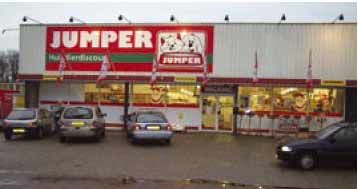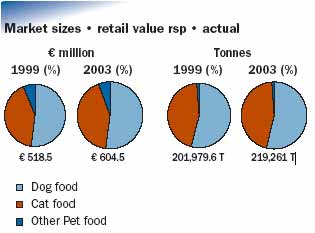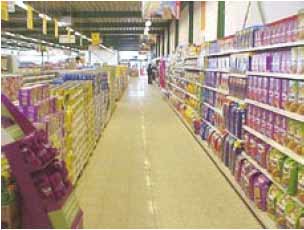Location politics
The Jumper stores are typically located on the outskirts, peripheral roads or access roads from city centres to the suburbs. The locations are characterised by their accessibility and ample car park facilities. A large number of Jumper stores have been set up as "shop-in-the-shop" outlets in the leading Dutch garden centre chain stores. High visibility and easy accessibility are important factors in choosing a location for a store. The outlets are located in cities with populations of 35,000 residents or more.
Commercial concept
The image that the company hopes to create and convey is one of a large-scale pet store with competitive prices and personal service. Jumper has a name for this – "shelf discounting," where the goods are available in net sales floor spaces ranging from 500 to 3000 m2 depending on the care area. Many self-service elements in the Jumper formula provide the consumer with the impression that they are doing the shopping for their pets in a sort of supermarket for pets. The assumption is to do what is best for pets, as far as this is possible. The concept of making a sale at any price is not the goal. Jumper gives the consumer the impression that they have made their purchase at the lowest possible price. A limited range of livestock is sold in the stores, and the shops are supervised by a veterinarian thus preserving the health and welfare of the animals.
Product range
In terms of livestock, Jumper limits the sale of live animals to rodents, a few species of birds, and fish. The criteria for the sale of small animals is based on how easily cared for the pet may be within a family, and how comfortable the animals are in a retail environment. Jumper does not sell reptiles or exotic fish. Jumper sells food and accessories for dogs, cats, small animals, fish and birds. For each animal in every segment of the market, the shops sell basic-, medium-, premium- and super-premium quality products, an extensive range of private labels which is also very broad in terms of product types, and extremely competitive vis-à-vis ranges that are sold in supermarkets and many pet specialty shops. At present, the share of turnover of Jumper's own brand is 7%. The objective, thanks in part to the introduction of its new private label products, is for its own brand to achieve a 15% share of the turnover by 2005. When it comes to accessories, it also has an optimum assortment of products available in various price ranges.
Product presentation
A great deal of attention is focused on the presentation of the products. The products are placed in the stores according to category and type of pet, and the in-store information helps the consumer even further in finding his or her way around the shop. The proper set-up and route is determined with the input of the whole team working in each store. Most customers visit the Jumper stores on a regular basis. For this reason, Jumper works to keep its shops attractive for the consumer by constantly running in-store price or premium promotions in conjunction with the suppliers and manufacturers. 
Customer loyalty strategy
Jumper works from the traditional assumption "value for money." It would appear that this works when one considers the increase in the average expenditure per customer which has grown by 17% in the last 5 years. The turnover rate of the products is monitored closely, and shelf position and breadth of the range serve as guides in controlling
these rates. Jumper has chosen to work with no-nonsense pricing; it does not give customers a stamp card or employ any other type of savings system in its shops.
Range management
Jumper applies the 80/20 rule within various product groups....20% of the offering in the market is responsible for 80% of the turnover. Jumper does not allow its suppliers
to determine the ranges it sells, although it does work very closely together with its suppliers.
EDI
All of the stores are fully automated, and all of the new shops to be opened will have to satisfy this requirement as well. In 2004, the shop computer system will be linked to the distribution centre in Arnhem in order to expand the level of efficiency and to facilitate just-in-time deliveries, for example. The organisation has worked with an extranet in its affiliated shops since 2002. The flow of paper to the shops has been minimalised, and the efficiency experienced in working with the shops is extremely high.
Distribution management
In October of 2003, Jumper invested in a new distribution centre to improve its supply to the shops and to facilitate the additional growth of a number of the shops. The distribution centre employs a complete distribution management system which makes real-time control in the depot possible. Most branches receive a shipment from the Distribution Centre twice a week. Direct deliveries from the suppliers to the shops are limited as much as possible.
Personnel training
Jumper offers its shop personnel the opportunity to participate in various educational programmes in order to expand their professional knowledge. The options include a basic pet shop course and/or specialised courses geared towards medicine and the use of medication.
Jumper is aware of the bonuses involved in achieving specific goals. For this reason, it has developed special incentives for its shop employees.
The management at Jumper works several days out of each year in various Jumper stores to gain a closer level of involvement with what happens on the shop floor and to prevent the occurrence of alienation from what goes on in its shops and with its personnel.
Source: PETS International Magazine
HOME - About PetsGlobal.com - Pet Industry Links - Update my company - Contact PetsGlobal.com
© 2001-2025 PetsGlobal.com All right reserved